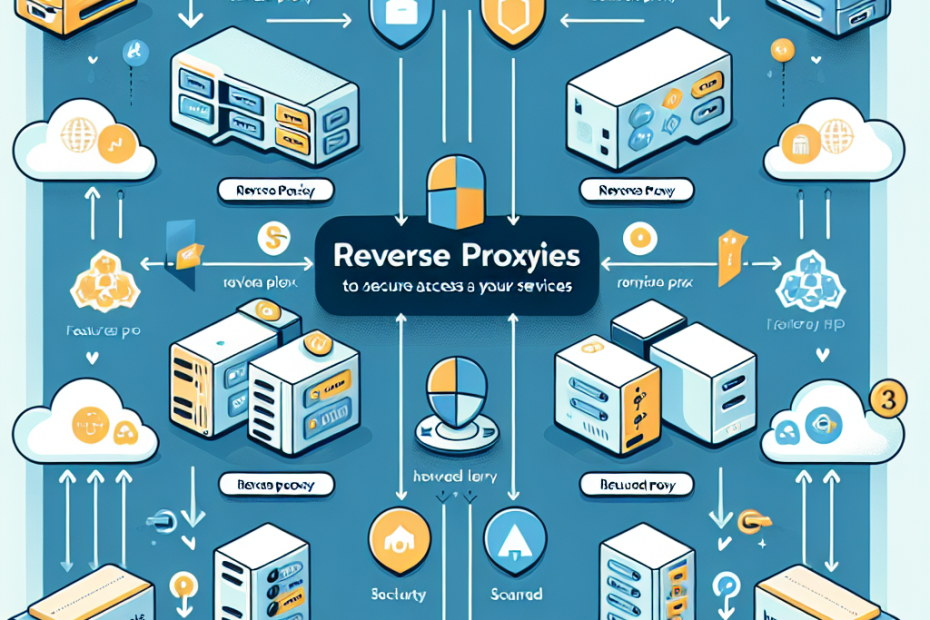Best Reverse Proxies for Homelabs: Secure and Simplify Access to Your Services
Why Use a Reverse Proxy in a Homelab?
Ah, the beauty of homelabs! It’s a world where I can tinker, experiment, and truly hone my skills without the pressure of a production environment looming over my shoulder. One of the most powerful tools I’ve discovered during my journey is the reverse proxy. It’s more than just a technical specification; it encapsulates both security and simplicity, allowing me to manage multiple self-hosted services effortlessly from one central point.
Imagine hosting a plethora of applications — from Nextcloud and Plex to Home Assistant — on various devices, each vying for attention through different URLs and ports. This is where the reverse proxy shines, transforming how I access my services. Instead of juggling numerous entries, I can access everything from a single domain, complete with distinct URLs or ports.
Here’s what draws me to reverse proxies:
- Streamlined Access: It centralizes my access to services, making navigation incredibly smooth.
- Enhanced Security: By obscuring my internal network structure, it provides a crucial layer of security against potential threats.
- SSL/TLS Encryption: It makes securing connections across my self-hosted applications a breeze — no more headaches over certificates and data safety.
Key Features to Look For in a Homelab Reverse Proxy
The excitement of setting up my homelab can sometimes lead to confusion, especially with the myriad options available. When selecting a reverse proxy, I keep a few essential features in mind, as they ensure I’ll have a smoother experience:
- SSL/TLS Support: This feature is non-negotiable. Proper security isn’t just nice to have; it’s a must.
- Ease of Configuration: My homelab is a playground for learning. A reverse proxy shouldn’t turn into a labyrinth!
- Performance: Request handling should be efficient with minimal latency — nobody likes waiting.
- Compatibility with Self-Hosted Apps: My reverse proxy needs to work seamlessly with common protocols like HTTP/HTTPS, WebSocket, and perhaps even some authentication plugins.
Top Reverse Proxies for Homelabs
Allow me to share some of my favorite reverse proxies that have stood the test of time and application:
1. Nginx Proxy Manager
Overview: If I had to choose a gateway for the uninitiated, it would be Nginx Proxy Manager (NPM). Based on Nginx, this open-source project boasts a user-friendly interface that I’ve found incredibly smooth to navigate. Managing proxy hosts, SSL certificates, and basic authentication is not only easier but also quite enjoyable.
Key Features:
- User-friendly web interface for quick setup and management.
- Integrated Let’s Encrypt support simplifying SSL certificate management.
- Custom domain redirects and access lists enhance control over traffic.
Best For: This is perfect for newcomers to reverse proxies seeking an intuitive experience.
Considerations: Those craving advanced features may find it lacking but there’s always room for custom configurations.
2. Traefik
Overview: If you’re tech-savvy and have a penchant for Docker or Kubernetes, Traefik is a superb fit. It brings a modern flair to reverse proxy configuration, supporting dynamic setups that respond to changes in real time.
Key Features:
- Automatic certificate generation with Let’s Encrypt is a major boon.
- Dynamic configuration using Docker labels or Kubernetes CRDs makes life a lot easier.
- A web dashboard for monitoring traffic is a delightful addition.
Best For: Advanced users will appreciate its flexibility, especially in Docker-centric environments.
Considerations: I will warn you: there’s a learning curve here, particularly for those unfamiliar with container orchestration.
3. Caddy
Overview: Caddy is magnificent for anyone who values automatic HTTPS capabilities. It takes care of provisioning and renewing Let’s Encrypt certificates, which means I can focus my energy elsewhere.
Key Features:
- Fully automatic HTTPS ensures my services are secure with minimal effort.
- Simple configuration syntax feels intuitive.
- In-built static file serving supports a variety of applications.
Best For: This reverse proxy is ideal for my smaller homelabs where ease and automatic security are priorities.
Considerations: While great, those accustomed to more powerful tools may find the features a bit limited.
4. HAProxy
Overview: For those times when I need high performance, HAProxy is my go-to option. It excels in handling large traffic volumes, making it both robust and reliable.
Key Features:
- Load balancing and failover support for complex traffic scenarios are essential for a smooth experience.
- Highly customizable configuration helps match diverse routing needs.
- Supports SSL/TLS with fine-grained control through access control lists.
Best For: HAProxy is perfect for heavy-duty tasks, especially in enterprise setups.
Considerations: The lack of a GUI might be daunting for beginners, as it often demands a deeper understanding of configuration.
5. Apache HTTP Server (with mod_proxy)
Overview: Apache is a familiar friend for many. Leveraging the mod_proxy module allows it to function as a reverse proxy with incredible stability.
Key Features:
- Endless customization options thanks to various configurations and modules.
- Strong SSL support with integration options for Let’s Encrypt.
- Load balancing capabilities through the
mod_proxy_balancer.
Best For: Existing Apache users will feel right at home, avoiding unnecessary frustration.
Considerations: Advanced Apache configurations can sometimes feel like navigating a maze, especially for newcomers.
Setting Up a Reverse Proxy in Your Homelab
There is a certain satisfaction in watching my reverse proxy come to life, but it requires some set-up:
Basic Setup
- First, install your chosen reverse proxy and make sure it’s operational on your server.
- Next, I configure DNS settings to point my domain (or subdomains) to my home IP address.
- Finally, I set up port forwarding on my router to allow HTTP/HTTPS traffic.
Configuring SSL/TLS
To secure my connections, I utilize Let’s Encrypt with my preferred reverse proxy. Whether it’s Nginx Proxy Manager or Caddy, automation is key. Keeping tabs on certificate renewals is also important, although many reverse proxies can handle this automatically.
Routing Multiple Services
To keep my services organized, I assign specific subdomains or paths to each app. Proper configuration in my reverse proxy setup allows traffic to flow seamlessly to respective internal IPs and ports.
Authentication and Access Control
Implementing basic authentication is another layer of security I consider, particularly for sensitive services. Some proxies, like Traefik, offer integrations that enhance my control over access management.
Choosing the Right Reverse Proxy for Your Needs
| Feature | Nginx Proxy Manager | Traefik | Caddy | HAProxy | Apache |
|---|---|---|---|---|---|
| Ease of Use | High | Moderate | High | Low | Low |
| SSL Automation | Yes (Let’s Encrypt) | Yes (Let’s Encrypt) | Yes (Automatic) | Yes (Let’s Encrypt) | Yes |
| GUI for Management | Yes | Yes (Dashboard) | No | No |
I hope you find this overview helpful as you embark on your own homelab adventures. Remember, investing time in understanding your reverse proxy will not only simplify your life but also significantly enhance security. I would love to hear your thoughts and experiences! Please leave a comment below; let’s learn from each other.



